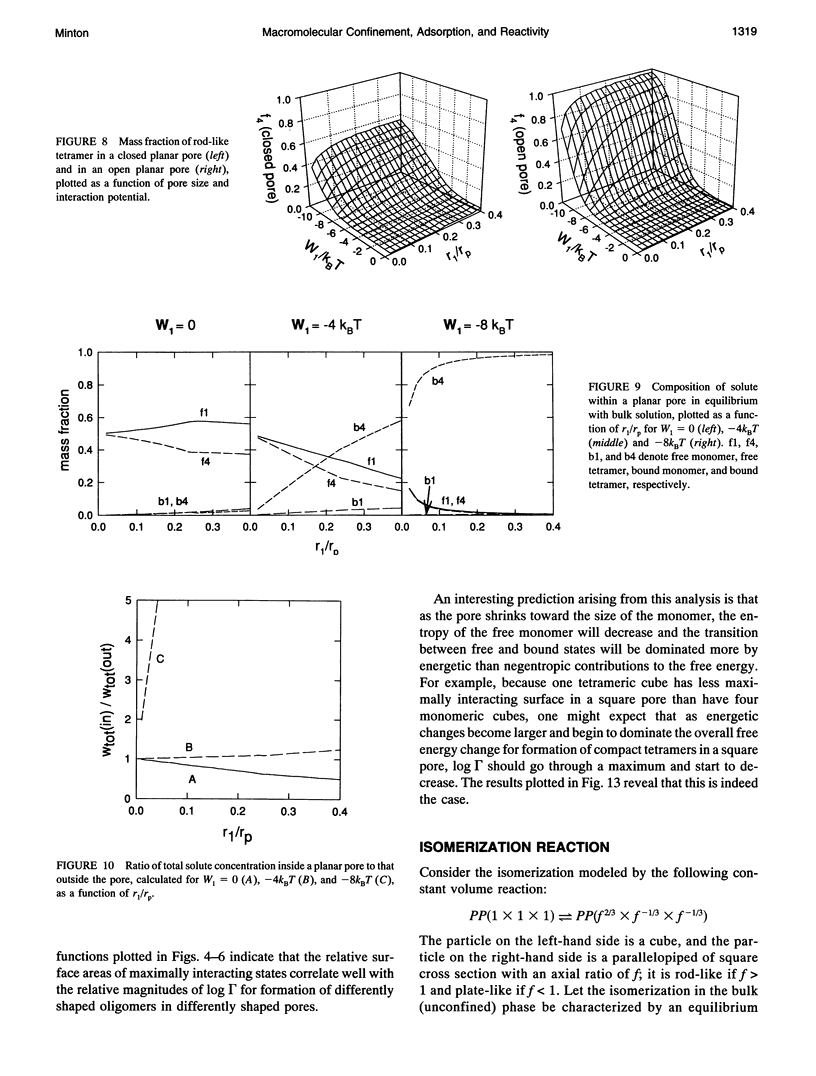Abstract
The effect of weak, nonspecific interaction between molecules confined within restricted elements of volume ("pores") and the boundary surfaces of the pore, upon the reactivity and physical state of the confined molecules, is explored by means of simple models. A confined molecule is represented by a rectangular parallelopiped having one of six orientations aligned with the cartesian coordinate axes, and the confining volume element is represented by a pair of parallel surfaces (planar pore), a tube of square cross section (square pore), or a cubical box (cubical pore). Weak interactions are modeled by square-well potentials having a defined range and well depth. Partition coefficients for distribution of molecules between the bulk and confined phase are calculated using an extension of the statistical-thermodynamic theory of Giddings et al. (1968). It is calculated that surface attraction with a potential of only a few kcal/mol monomer may result in large increases in the extent of self- or heteroassociation of confined molecules (as much as several orders of magnitude in favorable cases) linked to adsorption of the oligomeric species onto boundary surfaces. Calculations are also presented suggesting that surface attraction can lead to deformation of the native structure of adsorbed macromolecules. It is suggested that these findings are relevant to an understanding of the structure of eukaryotic cytoplasm.
Full text
PDF











Selected References
These references are in PubMed. This may not be the complete list of references from this article.
- Clegg J. S. Properties and metabolism of the aqueous cytoplasm and its boundaries. Am J Physiol. 1984 Feb;246(2 Pt 2):R133–R151. doi: 10.1152/ajpregu.1984.246.2.R133. [DOI] [PubMed] [Google Scholar]
- Frauenfelder H., Sligar S. G., Wolynes P. G. The energy landscapes and motions of proteins. Science. 1991 Dec 13;254(5038):1598–1603. doi: 10.1126/science.1749933. [DOI] [PubMed] [Google Scholar]
- Lakatos S., Minton A. P. Interactions between globular proteins and F-actin in isotonic saline solution. J Biol Chem. 1991 Oct 5;266(28):18707–18713. [PubMed] [Google Scholar]
- Leikin S., Rau D. C., Parsegian V. A. Direct measurement of forces between self-assembled proteins: temperature-dependent exponential forces between collagen triple helices. Proc Natl Acad Sci U S A. 1994 Jan 4;91(1):276–280. doi: 10.1073/pnas.91.1.276. [DOI] [PMC free article] [PubMed] [Google Scholar]
- Minton A. P. Confinement as a determinant of macromolecular structure and reactivity. Biophys J. 1992 Oct;63(4):1090–1100. doi: 10.1016/S0006-3495(92)81663-6. [DOI] [PMC free article] [PubMed] [Google Scholar]
- Muramatsu N., Minton A. P. Hidden self-association of proteins. J Mol Recognit. 1989 Apr;1(4):166–171. doi: 10.1002/jmr.300010404. [DOI] [PubMed] [Google Scholar]
- Richards F. M., Lim W. A. An analysis of packing in the protein folding problem. Q Rev Biophys. 1993 Nov;26(4):423–498. doi: 10.1017/s0033583500002845. [DOI] [PubMed] [Google Scholar]
- Rose G. D., Wolfenden R. Hydrogen bonding, hydrophobicity, packing, and protein folding. Annu Rev Biophys Biomol Struct. 1993;22:381–415. doi: 10.1146/annurev.bb.22.060193.002121. [DOI] [PubMed] [Google Scholar]


